After a long wait for an out-of-the-box kit of the A-4C Skyhawk, Hobbycraft
finally issued their C-Scooter two years after their initial announcement. Up
until the release of this kit the old Monogram kit could be built as an A-4C
using the KMC resin conversion, but at a much higher price. When my regular
hobby shop bought 12 A4-Bs and 12 Cs from Hobbycraft, they ran out of stock in a
matter of days!
Hasegawa has now issued its own Charlie these days so, regretfully, much of the
work I’ll explain below could have been saved!
In 1975, following the good results the Argentine Air Force was getting from
its A4-Bs (P for USA), it was decided to purchase 25 A-4Cs. These were stored in
a base in the USA and were bought “as is”, that is to say, without any
improvement and check of the systems. As a consequence, the radar APG-53 in only
6 of the planes could be used, as the others were unserviceable.
In 1982, during the Malvinas/Falklands war in the South Atlantic, only 14 planes
were available.
By the end May it was decided that a strike against any of the British aircraft
carriers was urgently needed, as the pressure introduced by the Harriers was
being felt by the Argentine garrison on the islands. HMS Invincible had been
detected by the point of departure and return of her planes by the radar at
Puerto Argentino (Port Stanley), among other electronic devices and
intelligence. It was circling 180 kilometers to the east of islands, well away
from the theorical reach of the land based planes. Therefore, the Argentine Navy
requested the service of the KC-130s to refuel their Super Etendards on their
way in. The Air Force accepted, but with the condition that 4 bombed laden
Skyhawks (the Cs were chosen because of the capability of refuelling and the
higher oxigen capacity) were to go with the Navy attack planes. After some
discussions, the plan was ready. The idea was to confirm the hit and maximise
the damage done by the missile. No one thought that it was possible to sink the
19,000 ton ship. The idea was to put it out of action for some days.
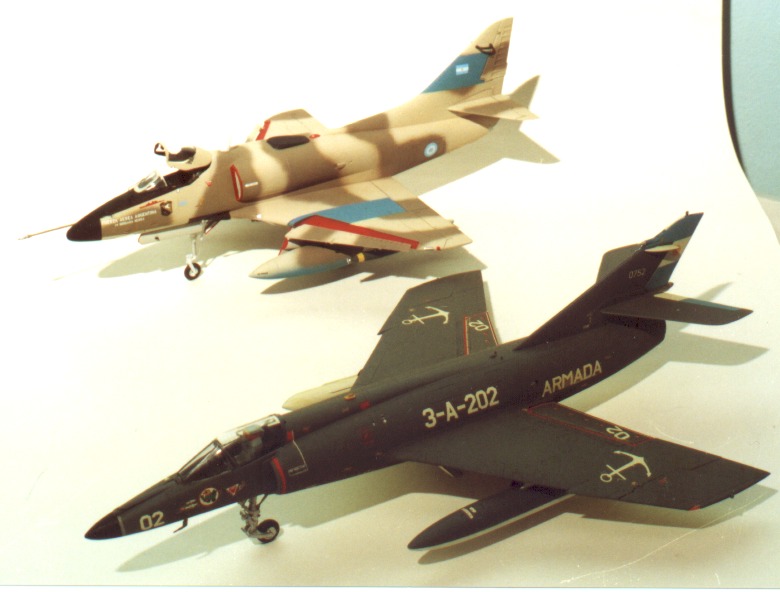
The original planned date of the strike was May 29th, but some technical
problems with the tankers and the Charlies made it necessary to postpone it one
day.
On May 30th, the most important mission in the history of the Argentine Air
Force took place. By midday (12:43 pm), the 4 Charlies and 2 SUE with the last
Exocet in stock in the country took off from Río Grande, in Tierra del Fuego
island. Some time before, the two tankers had taken off in different directions
to conceal their real mission (11.25 am).
After flying a couple of hours over the sea in a east bound direction, the
tankers met the 6 attack planes 200 miles to the south of the islands at the
right time and place. From then on, and during 200 kilometers, the planes
proceeded to reload their tanks several times in strict radio silence, in order
to have the fuel tanks loaded to the top at the moment of leaving the Hercules.
Once this was accomplished and flying on a point south east of the islands, the
attack planes turned into the attack formation: two SUEs in the middle (the
Exocet carrier slightly ahead) and two Charlies at each side. After refuelling,
the leader of the Skyhawks and his wingman were on the opposite sides of the
formation and with signs, he ordered this to be corrected - an adherance to the
plan that proved to be fatal for both of them.
After the separation from the tankers, the planes started their descent on north
westerly direction to only some meters above the surface of the sea, flying
through showers and over high waves. Their windshields were marked with salt
from the sea. From this point onwards, the SUEs ascended 3 times to iluminate
the target with their radars. Some beeps were found at the place where they were
told they would be, and finally they launched the last Exocet at 14:24 pm at the
biggest target. Radio silence was broken by the SUE leader: “Twenty miles! Right
ahead!” and then they returned to their base, leaving the four Air Force planes,
now sure to be detected, to carry out the last part of the plan. This last leg
of the inbound trip was to take 153 seconds: accelerting to their maximum speed,
the Charlies followed the smoke trail left by the missile. As this was faster
than them, they started losing it.
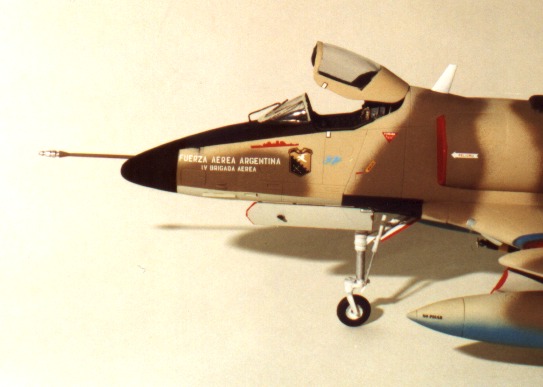
According to the testimony of the surviving pilots, they saw the carrier on the
horizon, just in time to see the flash of the impact of the missile. Now the
planes were converging on the target. Aproximately 10 kilometers away from
Invencible, a missile that no one saw coming hit the leader’s left wing (1st Lt.
Vázquez). The wing broke off and at the same time, the engine exploded. The
forward fuselage and the right wing fell to the left, giving the pilot no chance
to eject.
Now the leader was Lt. Ureta (#3), with each wing man to his side and behind.
Smoke was pouring from the side of the carrier, and anti aircarft guns of the
ship were firing at the attackers. The pilots were focused on their last details
before dropping the bombs. Only 2 kilometers away from the ship, Alferez Isaac
(#4, Ureta’s wing man) felt an explosion to his left. He looked in that
direction and saw Castillo’s (#2) plane expanding, the panels separating from
each other with an orange fire below. No chance to eject here either. (The two
planes on the left side of the formation had been brought down. Had Vázquez not
given the order to take the proper positions in the formation, he and his
wingmen would have survived and Ureta and Isaacs would be dead now).
Looking ahead, it was time for Isaacs to fire the guns and drop his 3 x 250
kilos bombs. The explosion had moved his plane out of position and aiming was
difficult. Ureta, leading the attack, heared or felt nothing. His guns jammed
after two shots, he aimed at the island of the ship, dropped his 3 bombs, jumped
over the carrier and took evasive maneouvers to avoid being shot down. Isaacs
followed suit. When both of them looked back, they only saw a huge mass of smoke
where Invincible was.
Due to their crazy aerobatics, they lost each other from sight, and each of them
thought that he was coming back alone. Ureta´s radio had broken down and was
unable to communicate with Isaac.
At 14:30 pm, the radar at Puerto Argentino/Port Stanley detected all the Harrier
PACs climbing to 12.000 meters and a major movement of British helicopters from
all over the islands heading east, where the fleet was.
Finally, Isaacs saw a spec in the sky and believing it was a Harrier he thought:
“I’m dead now, I’ve fired all my bullets, I’m alone and now the Harriers are
after me”. But as he got closer he found it was Ureta. Relieved, they found the
KC-130s that were circling alone in the sky waiting for them. They passed their
preliminary report (“two planes shot down on final leg of attack to the
carrier”), refuelled and returned to their base where they were immediately
separated and interrogated individually by Naval and Air Force intelligence
officers.
Great Britain denied that HMS Invencible was hit. The first version of the
attack issued by the British goverment was that the Argentine planes had hit the
burnt out hull of the Atlantic Conveyor, previously struck by Excocets on May
25th and that one plane had been shot down. But when it was found that this ship
had been at the North East of the islands, and that had already sunk two days
earlier (on the 28th), the version of events was changed to the official
following one.
The incoming raid had been detected by the radar of HMS Avenger and Exeter. The
carrier was in fact, 45 NM away from Avenger, the target that the Navy pilots
had mistaken for Invincible. A Sea Dart of Exeter shot down the first Skyhawk,
the second one being shot down by the guns of Avenger. The missile was either
confused by chaff or destroyed by the guns of Avenger. HMS Invincible continued
operating unmolested (and in fact, one of it’s Harriers shot down an AAF
Hercules on June 1st). The Air Force pilots had lied and mistook Avenger for the
carrier, due to their poor training in ship recognition.
The 4 AAF pilots were given the highest decoration of the Argentine Congress: la
Cruz al Heróico Valor en Combate (2 of them postumous). Only one more of this
was given to an Air Force officer: PMR Carballo and two to two non-commissioned
officers (sergeants).
Returning to the history of C-318, the plane flown by Isaacs on May 30th,
survived the war and kept giving service in the AAF until 1988 when it was
destroyed in an accident after a mechanical failure forced the pilot to eject
from the plane.
Hobbycraft's
A-4C Scooter
|
After waiting for so many years for a 1/48th Charlie to be issued by the
kit manufacturers, it was a dissapointment to see Hobbycraft’s offering.
As I mentioned in a posting to the Plane Talking discussion group, there
are aproximately 15 errors and/or omissions in the kit, instructions and
decals.
Construction
Or course, I started with the cockpit. I painted it black and they
drybrushed the panels on the side of the cockpit in green, to pick up
the cockpit side cushions. The instruments panel was painted in black,
drybrushed in silver and the glasses where made with tiny drops of
varnish.
The simple ejector seat was replaced by the Pavla resin item, and
painted. I used the lower ejection handle supplied by HC. Pedals, stick
and details on the consoles were painted and glued in place. Some
trimming of the lower part of the seat had to be done in order to permit
a better fit of the canopy. Both sides of the fuselage were glued
together, with the tricky placing of the nose wheel well and cockpit
taking quite a time to be achieved in the proper way.
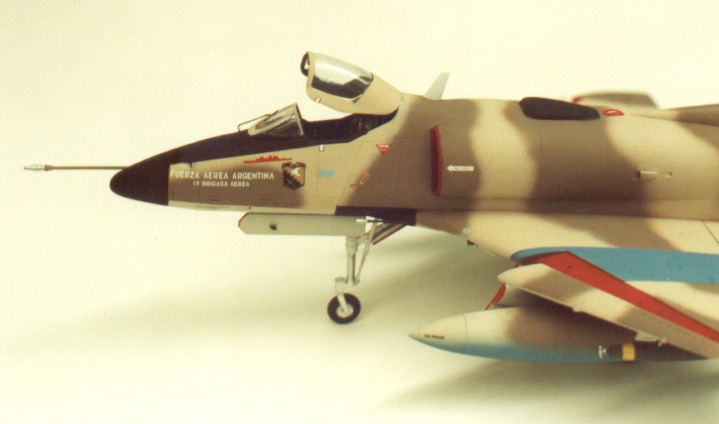
The instructions don’t mention the use of weight in the nose to avoid the
aircraft sitting on its tail. I didn’t put any weight inside the two nose
halves, and as a result I got a “tail sitter”. More of this and how I solved it
in a latter stage.
Some putty and sanding took place along the joints. On the kit there is a
triangular hole on the left side of the fuselage, below the cockpit that did not
exist in the Charlies of the AAF, so it was covered with putty and sanded to
oblivion. The next thing was to make the APX-6 radome below the tail of the
plane. Using Richard Caruna’s plans in Sept 99 SAMI, I scratch built it, glued
it in place and used some putty to cover the joint to the fuselage.
Now, for the dorsal radome. The kit supplied radome is completely wrong for the
A-4Cs in use in the AAF. It should be almost rectangular, with the lower end
almost merging with the fuselage. I used the radome that has no light, and
again, referring to R. Caruana’s drawings, cut it and filed it until I got what
I wanted. Putty was used to smooth the lines and union with the fuselage.
The lower wings were glued in place after some trimming. The upper halves were
dry-fitted and found that the part that they did not have the correct curvature,
so I very carefully retouched it until it fit correctly.
The instructions also omit to mention the use of the piece that represent one of
the position lights below the housing of left main landing gear. The hole in the
lower wing is too big for the piece, so after it was glued and left to dry,
putty was used to cover the huge gap.
The refuelling probe was glued in place and the cockpit was masked using tissue
paper. Another omission of the kit is a little rectangular antena on the lower
left side of the nose, which was made using my always-handy plastic Pasta Tray.
These two little fillets were added behind the tail. After breaking them off
twice during construction and painting, I left them aside and glued them at the
very last step.
The two outer wing stations (also omitted in the instructions for the AAF) and
the fuselage station were glued in place. The external fuel tanks were glued and
made ready for painting.
The instructions on the kit are correct for the upper surface colors, but
completerly wrong for the lower colors. The bottom of fuselage was given a coat
of light gray, which was also sprayed around the suspicious joints. Some more
putty and sanding was required to get a better nose/fuselage joint. Then, all
the undersurfaces were masked except for the wheel wells and the AXP-6 radome.
White paint was used for these places, the wheel hubs and arms, the arresting
hook and for the interior of the air intakes. Black was brushed where the engine
should be, at the end of the intakes.
To mask the arresting hook and get the white/black lines, I measured the width
of the lines with a ruler, marked them on masking tape, cut them with a scisor
(but not completely) and then presented to the hook. Once in place, the tape was
stuck to the hook except for the part that had to be exposed to be painted in
black. These parts of the tape were left out (like fingers) and now completely
cut out.
Once dry, the interior part of the intakes was masked and a little line was left
ready for the red paint that would come later. With the masking tape in place,
the intakes where glued in place, taking care for the glue not to touch the
tape. The bulk of the intakes was filled with tissue paper.
Now came the controversial top colors of the plane: after some discussion,
exchange of photographs and debate with some friends who didn’t trust HC scheme,
it was agreed that light sand (Humbrol 121) and brown (Humbrol 110 + 113) were
the right ones. (Light grey and green were applied AFTER the war).
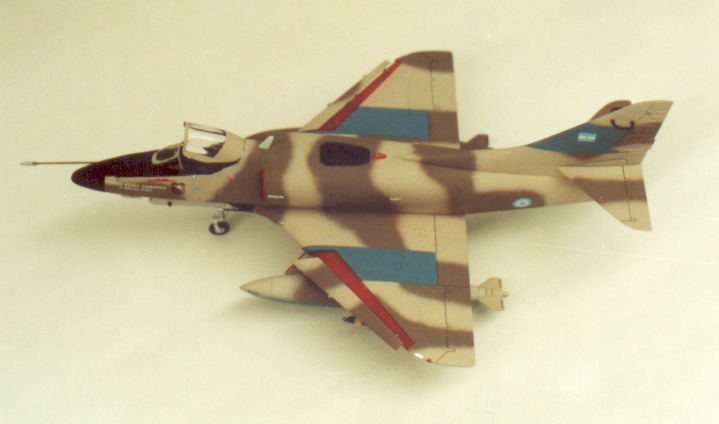
Then, the plane was masked to paint with:
Black: the nose and anti-reflectant panel, the wheels, the rectangular zone
around the 20 mm guns (I consider that the rectangular panel straight ahead of
the cannons below of the cockpit is too short in height) and the dorsal radome.
Also in black I painted the interior frames of the canopy and windshield. A
spray with sand finished the frames.
Turquoise (Humbrol 48): the identification bands carried by the Charlies during
the second part of the war, lower part of the external fuel tanks and stations 2
and 4.
Red: inner surfaces for the slats and flaps, air intake lips (with the fuselage
masked, leaving only a little line to be painted) and borders of the landing
gear doors.
Colors were applied in the following order: turquoise, black, red.
Green was used for the bombs, that were then masked and given yellow noses.
With a very sharpened pencil, I highlighted all the moveable surfaces (ailerons,
moveable base of the horizontal tail surfaces, rudder, air brakes). When
everything was ready, I sprayed clear varnish to put the decals later.
From Hobbycraft:
-
18 of the tail
-
escarapelas (roundels)
-
flag
-
Malvinas (though too light in color, they have
the right shape and better definition)
-
Yellow arrow “Rescate” below the cockpit
-
White rectangules of the canopy
-
Words in white “Fuerza Aerea Argentina – IV
Brigada Aerea”
From Aztec:
-
Stencils “No Pisar” of the fuel tanks
-
Grupo 4 badge
-
HMS Invincible silhoute
-
Red triangle with “Peligro” for the ejection seat
-
White arrow of the air intakes
With everything in place, the plane was sprayed with matt varnish.
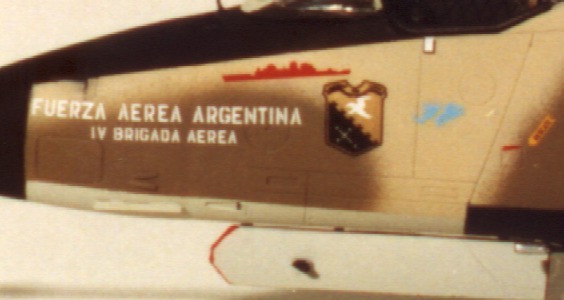
The little antena in the nose door was made using one of the unused ones of
the HC sprues, and painted black.
Stations # 2 and 4 were glued in place, as were the Omega antenas, the
horizontal surfaces of the tail, both 20 mm cannons, the flaps, the arresting
hook, the too thick exhaust tube and the landing gear.
And whoops, surprise!! I got a tail sitter. First I thought of placing the
arresting hook in a down position to keep the tail up, but I believe it’s too
fragile to stand the weight. Therefore, I asked a friend of mine (who also took
the pictures) to lend me the smallest buckshot (he is a hunter) he had in stock.
Using a dentist 45 degree plier and holding the nose down, they were given a
drop of superglue and, one by one, dropped inside the nose through the space
between the instrument panel and the cockpit floor. After this operation was
repeated around 15 times, the Charlie was no longer a tail sitter!
The nose landing gear door on the back is 1 mm too long, so I had to trim it to
make it fit.
All the doors were put in their places. The landing light of the right hand side
landing door was painted silver first, and then given a hand of light grey.
The slats were put in a deployed position using the silver painted arms.
The lights on the wings were painted in silver. The formation light behind the
dorsal dome was painted only on it’s base, leaving the pin without paint. By
doing this, you achieve a transluscent red piece, with a clear part in the
middle which represent the light itself.

Position lights on the bottom of the wings were also painted red (the clear
using using the technique mentioned above) and the ones on the wing tips were
painted red and green.
The bombs and external fuel tanks were glued to the stations.
The windshield was put in its place, after a sight was scratchbuilt. The pitot
tube was stucked on the nose, as the windshield wiper (made of stretched sprue
from a price tag).
A couple of mirrors (painted black on the back and silver on the front) and the
compass were scratch builted as well and glued to the canopy.
VHF antenna and the two tabs on the tail were the last to be put in place.
Now the pictures of the cockpit were taken and finally the canopy was glued in
the open position in order to try to “hide” the problems with the general shape
of this part in the HC kit.
I believe that with a lot of extra work the Hobbycraft kit can be converted
into an acceptable representation of the A-4C.
I am very pleased with the final result. I feel it is my tribute to these men
who flew over the cold sea in single engined planes without a chance of being
rescued if they had to bale out, to the chore of the enemy fleet, in a mission
that took them to a distance that was twice the range of their planes, and
ultimately gave their lives.
Juan Carlos Ostolaza, Fabian Nevarez and Steve Mazzarelli.
Sources:
-
Historia Oficial de la Fuerza Aérea Argentina,
Volumen 6, Tomos 1 y 2 (this is the ultimate and official version of the
argentine view of the war, issued by the AAF).
-
La guerra Inaudita – Rubén Moro
-
La batalla Aérea de Nuestras Islas Malvinas – Pío
Matassi
-
Dios y los Halcones – Capt. Pablo Marcos Rafael
Carballo
-
Halcones sobre Malvinas – Capt. Pablo Marcos
Rafael Carballo
-
Especial Alas Skyhawk – several authors
-
A4-P/C – Núñez Padín and others
-
No vencidos – Horacio A. Mayorga (Argentine Navy)
-
Aeroespacio – Interview to 1st Leutenant Ureta
-
Lecture given by 3 AAF veterans that I assisted
to in 1997 (Isaac gave a speech there and told his story)
-
Air War South Atlantic – J. Ethel & A. Price
-
Sea Harrier over the Falklands – Commander S.
Ward
Home
| What's New |
Features |
Gallery |
Reviews |
Reference |
Forum |
Search